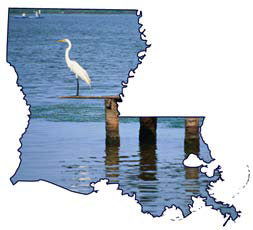LCA Science and Technology Program Discontinued, Holds Final Meeting
By Alisha Renfro, Ph.D., National Wildlife Federation
Last month, the Louisiana Coastal Area (LCA) Science & Technology (S&T) Science Board held their final meeting on November 15th in Baton Rouge. The S&T program was envisioned to support the LCA Ecosystem Restoration Plan by providing an external science review board; providing analytical tools and technology needed to reduce gaps in scientific knowledge; and to better integrate scientific knowledge at the local, state, and federal levels.
The S&T program closed due to a budget dispute between the State of Louisiana and the Army Corps of Engineers. This final meeting served as a wrap up of the program with presentations on new research that had been conducted and status updates on reports on the ecology of diversions and a guidance document for river diversions.
The meeting began with Dr. Mead Allison presenting his group’s work on determining the sediment and water budget of the Atchafalaya and Mississippi Rivers. For the future and success of the LCA restoration plan, it is critical to know how much sand is transported through the lower Mississippi River, where it is deposited and how much of it is lost to the Gulf. Preliminary discussion of the research results indicates that much of the sand that enters the lower Mississippi River is stored in the river channel or as overbank deposit. This work also indicates that greater sediment transport in the river is, in general, tied closely to high river discharge, but that direct monitoring work is needed to fine tune this relationship and account for other processes that increase sediment in the river at lower discharges. These results suggest that river diversion projects would be more effective when located higher on the river and should be operated when sediment transport in the river is at its highest.
The afternoon meeting focused on two highly anticipated reports—one of which will focus on developing a river diversion guidance document for managers and another on the ecology of diversions. The diversions ecology report was developed to explore information about river diversions, scientific uncertainties, scientific need to reduce uncertainties and maximize diversion effectiveness and operation recommendations for existing freshwater diversions to maximize their potential. The goal of the guidance document is to provide a rational basis for design, size, location and key project parameters as well as improving the methodology of diversion project design, implementation, and operation. Much of this work is still under review but should be released to the public in the near future.
Restoration of coastal Louisiana requires bold, ecosystem-scale restoration that is based on the best science available. Even with the dissolution of the S&T program, this pursuit of science-based restoration solutions must continue with groups like the Mississippi River Delta Coalition’s Science and Engineering Special Team (SEST) taking the lead. This group is comprised of scientists from various disciplines and throughout the U.S. that come together to try and answer the big questions in the pathway forward to restoring Louisiana’s coast.
